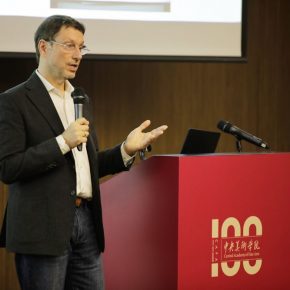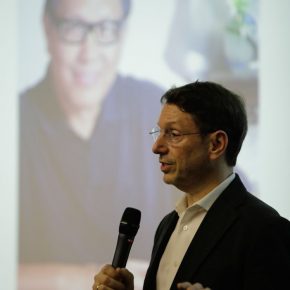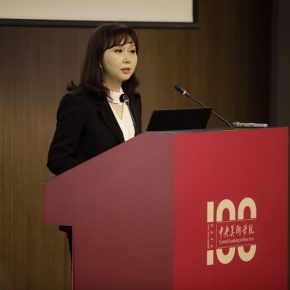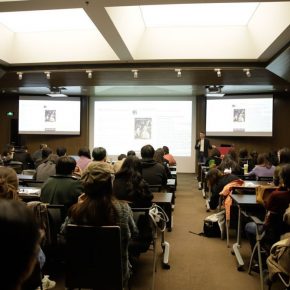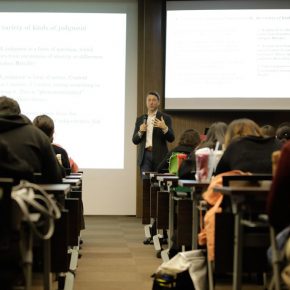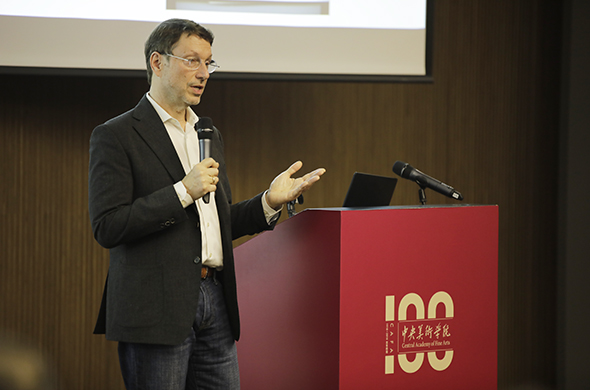
On 2 November, 2018, during the International Art Education Conference organized by the Central Academy of Fine Arts, James Elkins gave a lecture on “The End of Diversity in Art History, Theory and Criticism” which was an important part of the Art History Forum, at the academic lecture hall, Central Academy of Fine Arts. James Elkins is a professor of art history at the School of the Art Institute of Chicago, one of the pioneers and one of the leading theorists in the field of art history and visual culture. The lecture was hosted by Shao Yiyang, a professor of art history at the Central Academy of Fine Arts.
In this lecture, Elkins took the “North Atlantic” as the main point to form a discussion on the conflict between globalization and diversity in contemporary art history. Elkins declared that, “North Atlantic” sometimes meant the geographic region, but usually it meant historical art writing, and “North Atlantic” was an English-based historical art writing method, from the perspective of art history. He successively talked about the specific manifestations of the end of diversity in art criticism, art theory and art history.
In art criticism, Elkins started with “AICA” (International Association of Art Critics) to propose his view. First of all, he expounded the main objectives of AICA, to emphasize the global reach of the association, its cross-cultural ambitions and its interdisciplinary approach. They are: firstly, to promote art criticism as a discipline and contribute to its methodology; secondly, to protect the ethical and professional interests of its membership and defend their rights; thirdly, to encourage professional relationships within its active international member network; fourthly, to contribute to mutual understanding of visual aesthetics across cultural boundaries; fifthly, to defend impartial freedom of expression and thought and oppose arbitrary censorship. In Elkins’ opinion, AICA actually does not fulfill the above responsibilities, and failed in the promotion of the globalization of art criticism. He believes that art criticism may be a diverse practice. Art criticism is diverse, because, firstly most texts are very short, and they have not been studied; secondly, it is not practiced worldwide; thirdly, there are different “dialects”; fourthly, there is no agreement on judgment; fifthly, art critics follow a very wide range of other critics; sixthly, art critics are interested in a very wide range of artists. Elkins concluded that, art criticism is not studied well enough or defined to know if it is becoming uniform worldwide. Very few people study art criticism, and AICA does not study varieties or definitions of art criticism. There are reasons to suspect art criticism is more diverse than art history or theory, but it is not possible to be sure. (Much of art criticism is never translated out of its original language, making it especially hard to study.)
In art theory, Elkins believes that art theory may not be diverse, and it is global and uniform. Art theory may be a global practice, and the strongest way to argue art theory is not diverse but to note the prevalence of certain theorists in academia and on the international art world circuit. Most of these are poststructuralist, and most are French. French poststructuralist art theory is used as if it is universal – so that it can be applied to any art practice, and art theorists are often art historians. In his opinion, art theory appears universal partly because European philosophy since Hegel has experienced non-Western writing on art as something other than philosophy. Non-European, non-North-American theoretical writing on art has been described as “thought” rather than philosophy or theory. Non-European theorists also apply Western art theories in their own art studies (such as China). The best indication that “theory” seems universal but is actually North Atlantic in origin: no Chinese specialist in a Western university has been hired for expertise in Chinese interpretive methodologies, but many have been hired partly for their competence in Western interpretive methodologies, such as semiotics, feminism, psychoanalysis, post-structuralism, postcolonial theory. Elkins then introduced the Indian scholar Vinay Lal and his book History of History. It calls on other Indian scholars to write about non-European art using non-European interpretive methods and terms. Lai suggests that scholars of Indian art use the Puranas, for example, instead of Foucault’s discourse and power, Barthes’s structuralism, etc. But no one has answered his proposal. It also happens in China, Jim Cahill and Jason Kuo, for example, are both engaged in the studies of Chinese theories, which have not replaced the North Atlantic. On the other hand, Elkins expounded on art theory as a local practice, and one way to argue art theory as local or regional is to note how theory is used differently in different parts of the world. Some parts of the world have their own theories. But, in some cases the imbalance in knowledge is nearly total. For instance, non-Chinese readers typically do not know anything about Chinese art theory. Elkins made a conclusion about art theory that, art theory is almost entirely uniform worldwide, and it is strongly dependent on postwar French philosophy. The possible exceptions are regional and national practices of art theory in China, Germany, Latin America, Denmark, Sweden, the Baltic states, and India. But it is not clear that they are independent of the “North Atlantic” (namely European) sources, from Kant onward.
In art history, Elkins believes that the first question to resolve is to find some working definitions, and to learn what art history is. And he then expounded on three working definitions of art history, including methods, institutional forms, and narrative forms. Among, these are a set of methods, involving iconography, semiotics, structuralism, psychoanalysis, formal analysis, linguistics, gender studies, social art history, and historiography, in addition to the style analysis and connoisseurship which are now discarded ; there are a set of institutional forms, involving departments of art history, a “discipline” of art history, methodology course, conference, referenced journals, monographs and publishers, scholarly apparatus, and a privileged place in the archive, as well as the training distinct from aesthetics, practice, and art criticism. In narrative forms, Elkins declared that narrative forms were dependent on a certain kind of description in art history in different regions. And he took Steven Manshach’s Modern Art in Eastern Europe, and Polish art historian Piotr Piotrowski’s “vertical art history” as examples to explain it. In addition, Elkins also talked about the writing of art history, and some texts were highlighted. He put forward an idea of writing for and as art history. Some texts are usable as art history, potentially publishable, legible as (North Atlantic) art history, and they could be given in conferences or submitted as publications. And some texts are source materials for art history, for example, archives, biographies, chronicles, newspaper art criticism, and the things quoted by scholars. Half the contributors of Art and Globalization, which was edited by James Elkins and other people, felt that there are discourses in art history that are different from North Atlantic ones, but still comprehensible as art histories, and the other half thought non-Western discourse are best thought of as material for art history. Both sides assumed that there are different discourses in art history–that art history is diverse. He subsequently talked about the use of local concepts in art history, and introduced David Summer’s book Real Spaces: World Art History and the Rise of Western Modernism, which implicitly raises the possibility of five models for art history: firstly, art history can remain as it is; secondly, art history can try to generalize its basic (Greco-Roman) concepts; thirdly, art history can use “new,” culturally specific concepts; fourthly, art history can use culturally specific methods; fifthly, art history can dissolve, perhaps into visual studies. In the end, Elkins analyzed the art history based on the use of culturally specific concepts, and put forward an idea of “normal art history.” Elkins made a conclusion about the use of culturally specific concepts, and he believed that these discussions were generally inconclusive, because conversations about translation trended to be about the distortion, misunderstanding, and approximation in all translations, and because the concepts used to define these “unfamiliar” concepts were themselves European, especially space and time. Obviously, Elkins accepted that the West was still the center of the world, and he declared that, worldwide, art history was focused on national and regional traditions, but statistically, few art historical journals participate in the international discourse of theories. Elkins has called this “normal art history”–in the sense of statistically average (not a judgment). And he asked a question on how, from the perspective of “global” interests, to understand “normal” (national and regional) art history. Was it as a sociocultural phenomenon? Or as an integral part of the project of “global” art history? Elkins then responded to it with three examples of “normal” art history, including Hans Belting’s book The Germans and Their Art, Edith Tomory’s A History of Fine Arts in India and the West, and Burhan Toprak’s Sanat Tarihi (History of Art).
Also, Elkins briefly introduced two examples: Travel Grants and the Clarks Art Institute’s Mellon Grant project to study art history in different parts of the world. On the one hand, Travel Grants were poor in the theory to run a project, and the diversity has been reduced in the process of its promotion of globalization. On the other hand, Elkins believes that the Clarks Art Institute’s Mellon Grant project avoided part of the communications. At the end of the lecture, Elkins introduced the art historical practices outside “North Atlantic”, and illustrated this with three examples: Georgia, Iran and China. He said that those three countries faced the problem of communication in the process of globalization, and he declared that it resulted in multiculturalism, while the writing in multiculturalism was accompanied by misunderstandings and errors because of cultural differences. There was a critical spirit in some areas and not in others, and also, he accepted that people should consider it based on a specific culture. Elkins carefully expounded on his thoughts and practices of the subject, in general, what he considers to be the end of diversity is that art history, art theory and art criticism start to converge under the influence of the North Atlantic art system, which led to the end of diversity.
Text by Chen Gongbu, translated by Chen Peihua and edited by Sue/CAFA ART INFO
Photo courtesy of the organizer


